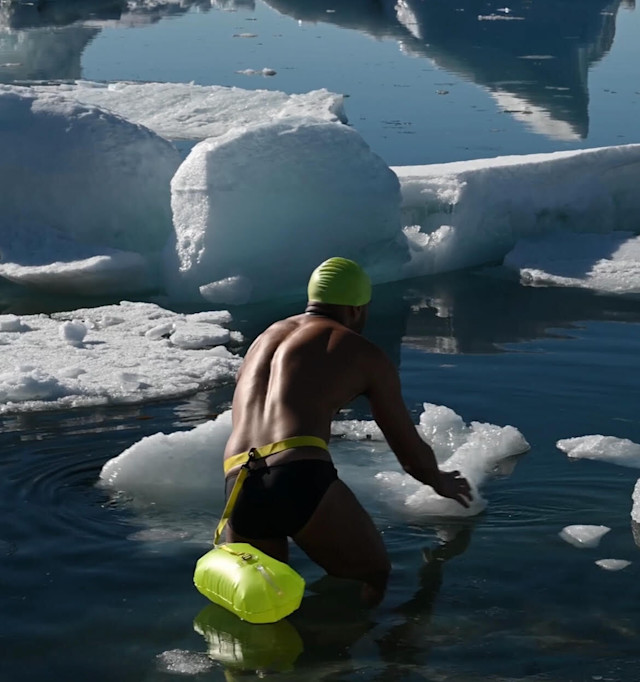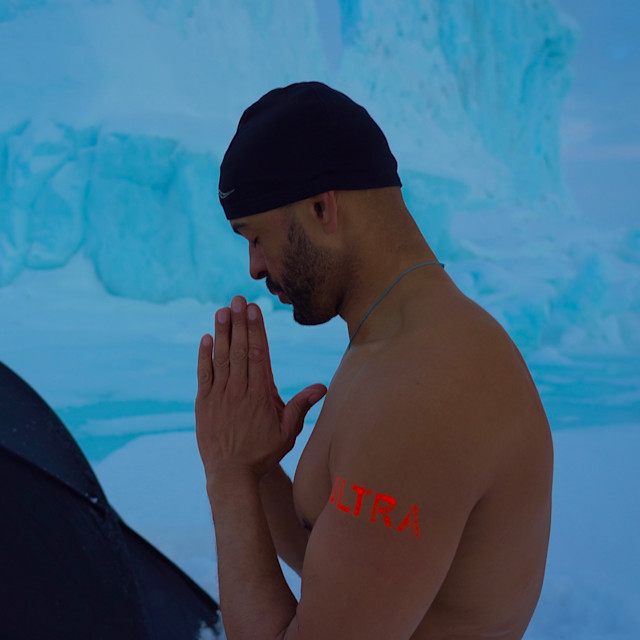Equinox member Vladimir Aslan has raced across the Arctic tundra and swam next to glaciers — and that’s only the tip of the iceberg.
During the COVID-19 quarantine, many people picked up new hobbies like knitting or sourdough baking. Equinox member Vladimir Aslan did, too, though his new pastime wasn’t quite as cozy: That’s when he became infatuated with exercising in the extreme cold.
Aslan, 41, lives in New York City but grew up in Ukraine and previously lived in Siberia, Russia. He’s always been an athlete, running since he was 10 and competing in professional wrestling in his 20s. He settled into a “regular” life, but then, in his 30s, during the pandemic, he had a sort of awakening.
“I started running seriously in extreme cold around COVID time, especially when all the gyms were closed,” Aslan says. At the same time, he was reading a lot about psychology. “I got really interested in this idea: What’s behind human limits? And it was all driven by spirit. I discovered within myself this indescribable drive.”
It began when Aslan did a winter run in just a T-shirt. “It felt good: different,” he says. “I felt clear. I felt elevated.” He started testing his limits with no real goal in mind — tacking on cold showers and cold plunges, going out for runs in chillier weather with fewer layers. He started swimming in the Atlantic Ocean, no matter the season, gradually increasing his distances.
“I didn’t expect it would become a big project or a big deal. There was just something about it… and I wanted to know what was deeper,” he says. “When you’re excited about something, truly inspired, new doors start opening, and you begin to think about something bigger.”
For Aslan, that “something bigger” has snowballed beyond imagination. His New York winter training inspired him to head expeditions north of the Arctic Circle, logging miles along snowy landscapes and swimming strokes beside icy glaciers. He’s since quit his day job to focus on his next adventure: a likely record-breaking feat (coming in 2025!) chronicled by his self-funded Black Iceberg Films. And really, the only thing more shocking than what Aslan’s already accomplished is what he’s likely to do next.

RELATED: The Art of Wintering
Pushing Limits at the Ends of the Earth
Since Aslan’s infatuation with the cold began, he’s gone on an expedition to Iceland, where he swam in Jökulsárlón, a stunning glacial lake, and completed a treacherous run up Vatnajökull glacier, Europe’s biggest glacier. He traveled to northern Greenland to run a half marathon, covering the 13.1 miles shirtless and in shorts, despite the 0°F temps.
This past October, Aslan ran the Polar Circle Marathon in Kangerlussuaq, Greenland — this time with a singlet on. He finished 10th out of 126 starters with an impressive time of 4:15:05, despite fighting the frigid cold and frostbite on two of his fingers.
Aslan also swam close to a mile in Greenland’s Ilulissat Icefjord, a UNESCO World Heritage Site where a fast-moving glacial stream calves icebergs out of the glacier — and Aslan says only two other gutsy swimmers have jumped in. (That includes Lewis Pugh, who famously did so in 2021 to raise awareness about climate change.) “The waters are extremely cold, 28°F, stinging. It’s survival time,” he says — yet, “that was one of the most beautiful experiences I saw with my own eyes.”
While in Greenland, Aslan also trekked up to one of the northernmost settlements in the world, where he completed a brutal ice run that turned into blizzard conditions with zero visibility. “We started around 10 p.m. and finished around 3 a.m., so the run was over four hours in deep snow,” he says. “In my life, I haven't experienced anything more difficult than that day, except swimming [in Greenland]. But that was also part of the magic.”
It might sound like no big deal when rattled off in a list, but Aslan is the first to admit: “We are not absolutely designed for these temperatures.” Every time he jumps into frigid water or starts an Arctic tundra run, there’s the risk of permanent damage from frostbite — not to mention the possibility of running into polar bears or sharks, falling iceberg chunks, tsunamis of icy water, or hidden snow wells or ice crevasses. The cold poses new challenges that mean you have to rethink the basics of your swim or run strategy; goggles start to freeze and crack, letting water in, while running gels, electrolytes, energy gels, and water all freeze solid, becoming inconsumable.
I feel like I’m discovering myself, discovering nature, and I just feel connected.
With all its risks, the cold is still enchanting to Aslan. “There’s something about the ice, something in the Arctic areas, something pristine and clear,” he says. “Cold is really deeply connected to psychology...It really affects us, and we can get hooked on it, that's for sure. I know it myself; that's how it all started.”
Religious cold plungers might agree, but with Aslan’s expeditions, the current runs even deeper; it’s not just about the cold but about being in an environment unlike anything you’ve ever seen. When you’re venturing to places that feel so removed from the modern grind, it also offers an escape from reality. In fact, Aslan says he has trouble getting himself to even return to society. As soon as he’s home from one trip, he’s trying to figure out how he can go back.
“On one expedition, I was on a boat far from a village, swimming under ice that looked like clouds, and that world — it’s hard to describe. Once you see it, you want to come back as soon as possible,” he says. “I feel like I’m discovering myself, discovering nature, and I just feel connected.”
RELATED: A 155-Mile Run Through Mongolia
Aslan’s Next Great Adventure

Aslan’s past accomplishments have all been stepping stones towards his newest, biggest project yet — a film he describes along the lines of Free Solo, The Deepest Breath, or Nyad and anticipates being “one of the brightest, most breathtaking and shocking documentaries” out there. The details are still under wraps, but you can expect him to attempt three Guinness World Records in places where no human has been before. (One of which may take place near the Drake Passage, the infamously rough waters stretching more than 600 miles between the southernmost tip of South America and the Antarctic Peninsula.)
You can add these upcoming feats to the list of seemingly impossible things Aslan has pulled off. His secret weapon for defying human nature? "Visualization — you have to visualize,” he says. “You have to see it clearly. You have to be so inspired by it and driven, you have to breathe it. You become something else."
Images Courtesy of Vladimir Aslan
